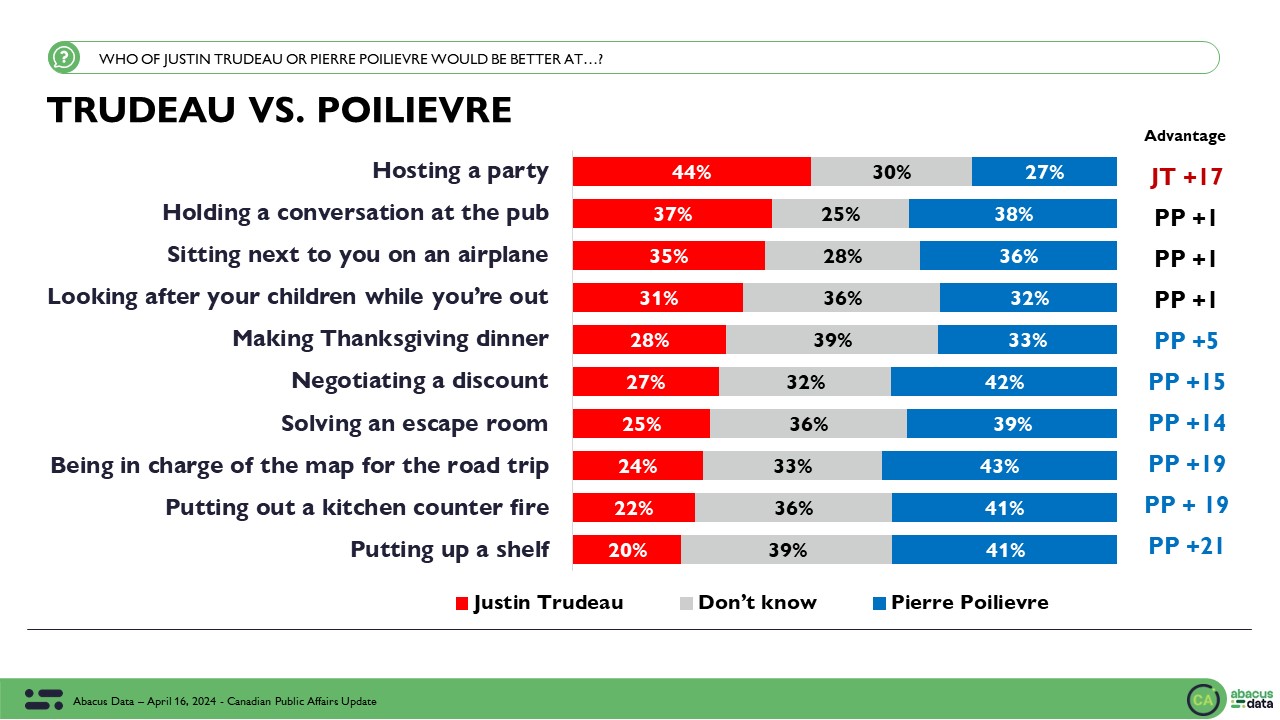GOVERNMENT APPROVAL HITS NEW HIGH OF 56% AS HOUSE RISES
June 22, 2016

Our latest nationwide survey included some of our recurring measures about the state of public opinion on federal politics.
The highlights:
FEELINGS ABOUT THE GOVERNMENT
• 56% approve of the job being done by Justin Trudeau and his government, the highest number achieved by the new government. Only 24% disapprove.
• More approve than disapprove of the government’s performance in every region of the country. This is the second time we have seen more people in Alberta approve (41%) than disapprove (38%) of the performance of the Trudeau government. The last time was in November 2015, right after the election.
• Among Conservative voters, about one in five (19%) approve of the government’s performance. A solid majority (62%) of NDP voters approve.



FEELINGS ABOUT THE LEADERS
• Since his swearing in last November as Prime Minister, Justin Trudeau has found very little fluctuation in his personal support level. Today, 55% say they have a positive feeling about Mr. Trudeau, more than twice as many as say they have a negative feeling (23%).
• Feelings about Mr. Trudeau are more positive than negative in every region of the country, including Alberta, where 36% say they have a good feeling about the PM, and 33% say they see him in a negative way.
• 62% of Conservative voters don’t like Mr. Trudeau, but only 15% of NDP voters feel that way.



• For the second month in a row, Thomas Mulcair encounters more negative (29%) than positive (25%) feelings. Since the launch of the election campaign last August, Mr. Mulcair’s positives dropped 16 points, and his negatives have risen by 8.
• Mr. Mulcair’s negatives are higher than his positives in every region but Quebec (39% positive – 22% negative). Among NDP voters, 59% have a positive feeling about Mr. Mulcair.



• Interim Opposition Leader Rona Ambrose also engenders more negative (24%) than positive (19%) opinion. This has been the case since she took on this role. Worth noting is that positive feelings about Ms. Ambrose have climbed from 14% to 19%.
• 53% of CPC voters have a positive feeling about Ms. Ambrose, while only 9% of Liberal voters and 7% of NDP voters feel that way.



VOTING INTENTIONS
• If an election were held tomorrow, 44% say they would vote Liberal, 28% CPC, and 16% NDP. Since the election, support for the Liberal Party has been consistently in the 40% to 46% range; the Conservatives have been in the 26% to 32% range. The NDP have been consistently below the 20% share of the vote they received last October.

• In Ontario, we see some tightening of the competition between the Liberals and Conservatives, as Liberal support has dipped a bit from the 53% highs we saw immediately after the budget. Today’s Ontario splits (LPC 45%, CPC 33%, NDP 14%) are very similar to those on Election Day last fall (45-35-17)
• In Quebec, the Liberals maintain a striking 28 point advantage over their nearest competitors, the NDP. These numbers represent a substantial 10 point gain for the Liberals over their result last October.
• In BC, the Liberals have opened up a 20 point advantage over the Conservatives – compared to the 5-point advantage last Election Day.



• If an election were held tomorrow, the Liberals would see 3% of their 2015 supporters shift to the CPC, while the CPC would see 6% of their 2015 supporters switch to the Liberals. The movement with the NDP is more compelling: only 4% of those who voted Liberal in October would switch to the NDP, while 20% of those who voted NDP would now vote Liberal.


THE UPSHOT
According to Bruce Anderson:
“Since the election, the new government has taken action on a number of its highest profile promises, including bringing in 25,000 refugees, cutting taxes for the middle class, ending our combat mission in Afghanistan, introducing a new Family Benefit, signing an international protocol on carbon emissions, putting in place new processes to evaluate pipeline projects and spending significantly on infrastructure.
Along the way, the conditions have been set for a much larger deficit than was promised.
In addition, the Prime Minister was on the international stage in a wide range of meetings from Davos to Turkey to Washington to Japan.
Throughout, Liberal support has generally strengthened a bit, largely as a consequence of NDP voters feeling well served by the agenda of this government.
Finally, perhaps most notable in these findings are the perceptions of Mr. Trudeau. In a sense, he has moved from receiving “the benefit of the doubt”, to a measure of confidence in his ability to handle the job and trust in his motives.”
According to David Coletto:
“The Liberal government ends the parliamentary session in much the same place it started: well regarded.
A majority of Canadians have a positive impression of the Prime Minister, the Liberal Party would get a larger share of the vote today than it did in October’s election, and more people approve of the government’s performance than at any point in its seven month tenure.
They have so far held together the coalition that elected them, with a majority of Canadians from all regions of the country (except for Alberta), all generations, and all genders approving of its performance to date. Moreover, they have earned the approval of six in ten Canadians who voted NDP demonstrating the appeal of its agenda and approach, as well confirming the deep desire for change most progressives were craving at the end of the Harper era.”
Methodology
Our survey was conducted online with 1,500 Canadians aged 18 and over from June 14 to 16, 2016. A random sample of panelists was invited to complete the survey from a large representative panel of over 500,000 Canadians.
The Marketing Research and Intelligence Association policy limits statements about margins of sampling error for most online surveys.
The margin of error for a comparable probability-based random sample of 1,500 is +/- 2.6%, 19 times out of 20.
The data were weighted according to census data to ensure that the sample matched Canada’s population according to age, gender, educational attainment, and region. Totals may not add up to 100 due to rounding.
Abacus Data Inc.
We offer global research capacity with a strong focus on customer service, attention to detail and value added insight. Our team combines the experience of our Chairman Bruce Anderson, one of Canada’s leading research executives for two decades, with the energy, creativity and research expertise of CEO David Coletto, PhD.
For more information, visit our website at http://www.abacusdata.ca/




